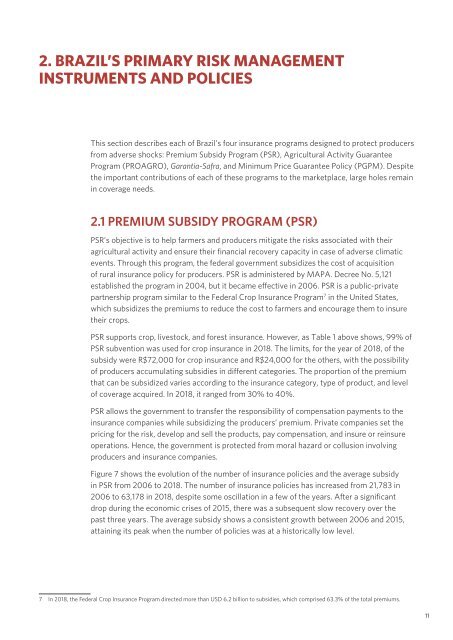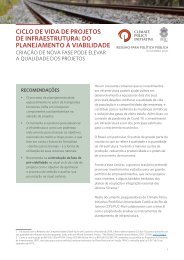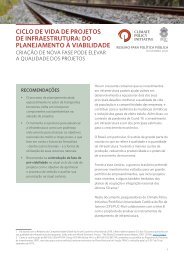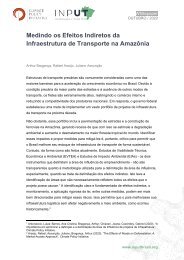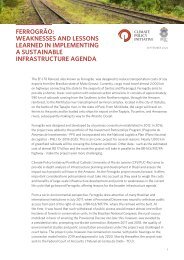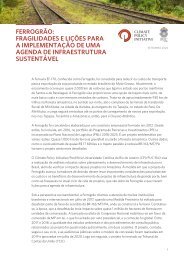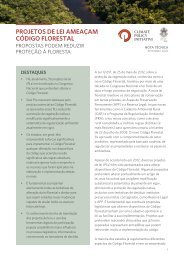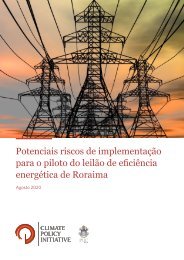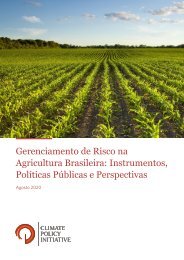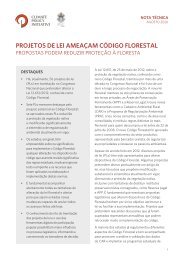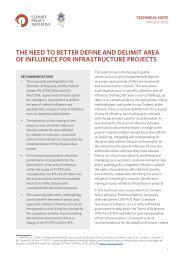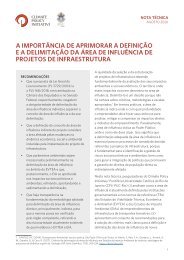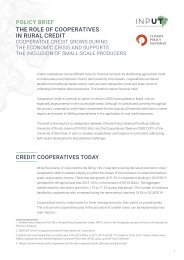Report - Risk Management in Brazilian Agriculture
You also want an ePaper? Increase the reach of your titles
YUMPU automatically turns print PDFs into web optimized ePapers that Google loves.
2. BRAZIL’S PRIMARY RISK MANAGEMENT<br />
INSTRUMENTS AND POLICIES<br />
This section describes each of Brazil’s four <strong>in</strong>surance programs designed to protect producers<br />
from adverse shocks: Premium Subsidy Program (PSR), Agricultural Activity Guarantee<br />
Program (PROAGRO), Garantia-Safra, and M<strong>in</strong>imum Price Guarantee Policy (PGPM). Despite<br />
the important contributions of each of these programs to the marketplace, large holes rema<strong>in</strong><br />
<strong>in</strong> coverage needs.<br />
2.1 PREMIUM SUBSIDY PROGRAM (PSR)<br />
PSR’s objective is to help farmers and producers mitigate the risks associated with their<br />
agricultural activity and ensure their f<strong>in</strong>ancial recovery capacity <strong>in</strong> case of adverse climatic<br />
events. Through this program, the federal government subsidizes the cost of acquisition<br />
of rural <strong>in</strong>surance policy for producers. PSR is adm<strong>in</strong>istered by MAPA. Decree No. 5,121<br />
established the program <strong>in</strong> 2004, but it became effective <strong>in</strong> 2006. PSR is a public-private<br />
partnership program similar to the Federal Crop Insurance Program 7 <strong>in</strong> the United States,<br />
which subsidizes the premiums to reduce the cost to farmers and encourage them to <strong>in</strong>sure<br />
their crops.<br />
PSR supports crop, livestock, and forest <strong>in</strong>surance. However, as Table 1 above shows, 99% of<br />
PSR subvention was used for crop <strong>in</strong>surance <strong>in</strong> 2018. The limits, for the year of 2018, of the<br />
subsidy were R$72,000 for crop <strong>in</strong>surance and R$24,000 for the others, with the possibility<br />
of producers accumulat<strong>in</strong>g subsidies <strong>in</strong> different categories. The proportion of the premium<br />
that can be subsidized varies accord<strong>in</strong>g to the <strong>in</strong>surance category, type of product, and level<br />
of coverage acquired. In 2018, it ranged from 30% to 40%.<br />
PSR allows the government to transfer the responsibility of compensation payments to the<br />
<strong>in</strong>surance companies while subsidiz<strong>in</strong>g the producers’ premium. Private companies set the<br />
pric<strong>in</strong>g for the risk, develop and sell the products, pay compensation, and <strong>in</strong>sure or re<strong>in</strong>sure<br />
operations. Hence, the government is protected from moral hazard or collusion <strong>in</strong>volv<strong>in</strong>g<br />
producers and <strong>in</strong>surance companies.<br />
Figure 7 shows the evolution of the number of <strong>in</strong>surance policies and the average subsidy<br />
<strong>in</strong> PSR from 2006 to 2018. The number of <strong>in</strong>surance policies has <strong>in</strong>creased from 21,783 <strong>in</strong><br />
2006 to 63,178 <strong>in</strong> 2018, despite some oscillation <strong>in</strong> a few of the years. After a significant<br />
drop dur<strong>in</strong>g the economic crises of 2015, there was a subsequent slow recovery over the<br />
past three years. The average subsidy shows a consistent growth between 2006 and 2015,<br />
atta<strong>in</strong><strong>in</strong>g its peak when the number of policies was at a historically low level.<br />
7 In 2018, the Federal Crop Insurance Program directed more than USD 6.2 billion to subsidies, which comprised 63.3% of the total premiums.<br />
11


